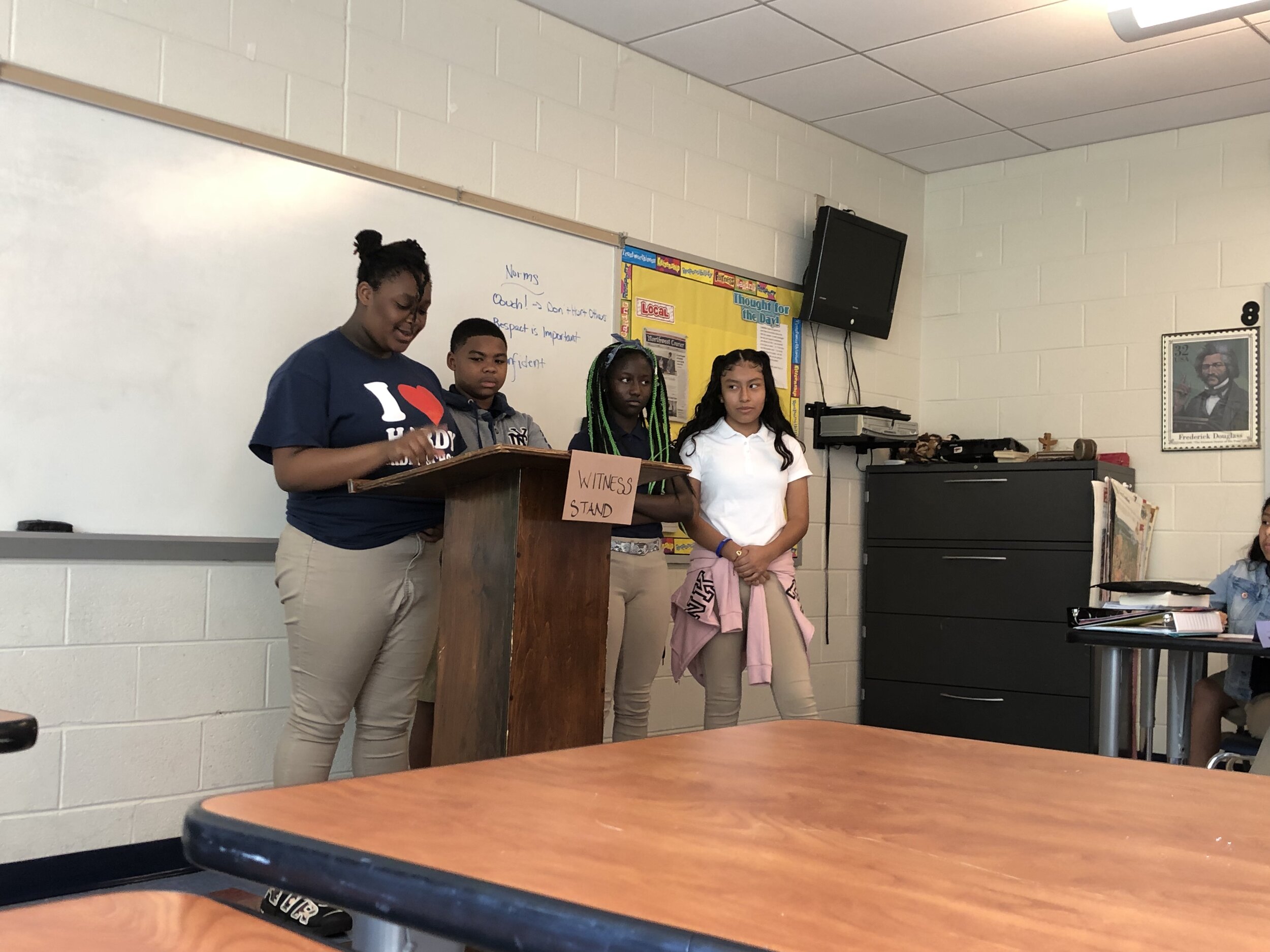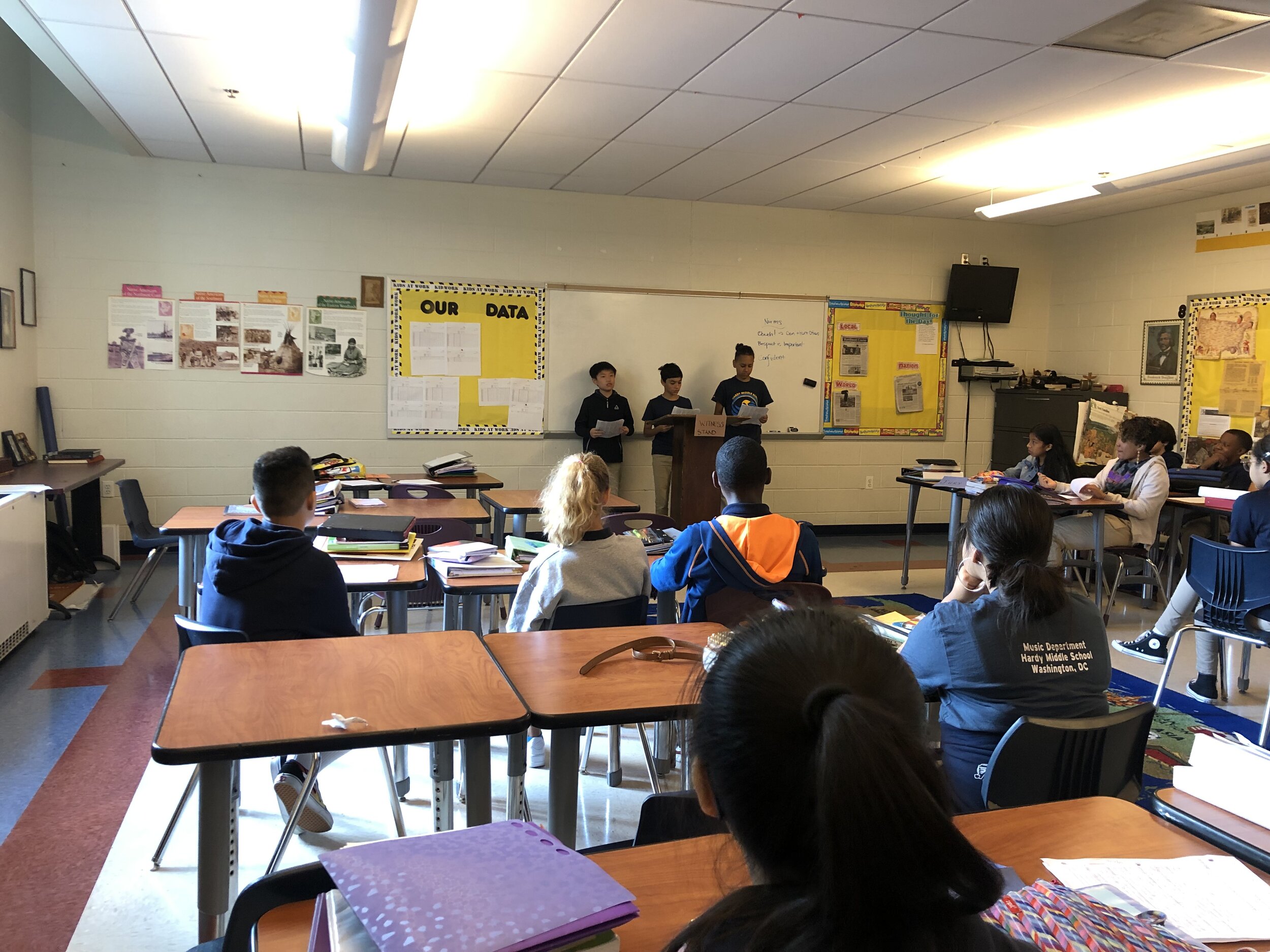Guilty or Innocent? Hardy MS Students Put Columbus on Trial
If you had to put Christopher Columbus on trial for murder, would he be considered guilty? Students in an 8th-grade U.S. History class at Hardy Middle School in Washington, D.C. grappled with this question when they were assigned the task of deciding who would be considered guilty for the deaths of millions of Taínos on the island of Hispaniola in the 1490s. This lesson by Bill Bigelow (in Rethinking Columbus: The Next 500 Years) invites students to take on the roles of Christopher Columbus, Columbus’ men, King Ferdinand and Queen Isabella, Taínos, and even the system of the empire.
The teacher started the lesson by taking a moment to pause and set community agreements with the class that would guide their interactions and participation in the trial role play. When asked what community agreements they would like to add to the list, students called out,
Be confident. Respect one another.
The teacher reassured the group that they are here to support one another, which was a reminder that even when conversations get difficult and even when they disagree, they must show mutual respect.
As the group representing Columbus took the stand, they lined themselves in a row, talking points in hand, ready to defend their case. Columbus’ group argued,
I was just following the order of the King and Queen. I was ordered to take possession of other people’s land in the name of the empire, which was thousands of miles away.
The premise of Columbus’ case (as argued by the students) was that he was forced to take the land, out of fear of retaliation by the king and queen if his conquest wasn’t successful. He claimed he didn’t know that the diseases he and his men carried would harm people and that he did what he had to do, even if that meant taking the lives of others in order to control the territory and seize natural resources. He also wanted to spread Christianity, which he felt gave him the right and reasoning to take land from those who weren’t Christian or wouldn’t convert to Christianity.
The jury, a group of students which was composed of one student from each of the defendant groups, were instructed to deliberate for two minutes. They ultimately ruled Columbus as guilty of murder, with no questions asked. Next, Columbus’ men took the stand. They immediately blamed the killings on Columbus. They exclaimed,
We were tricked by Columbus. We were faced with either helping Columbus or being sentenced to death.
Additionally, they alleged that Columbus deceived the Taíno by asking them for gold and threatening to kill them if they didn’t comply with his demands. They also asserted that Columbus captured and enslaved over 500 Taíno to bring them back to Spain as a gift for King Ferdinand and Queen Isabella. Although the king and queen did not ask for Columbus to enslave any of the Taíno people, but rather explore and take over the land to expand the Spanish empire, Columbus did it anyway.
Each group had to write their opinion on whether or not other groups were guilty, which allowed them to step in and out of character. This exercise encouraged them to think critically because they were analyzing the situation through multiple perspectives — that of their own and of the role they were embodying.
As Columbus’ mens’ representatives closed their statement, the jury reflected on the testimony and found Columbus’ men to be 25% guilty. The jury’s reasoning was that although they were responsible for the murder of the Taíno people, they were threatened and couldn’t escape. The jury agreed that Columbus’ army had no choice.
The group representing King Ferdinand and Queen Isabella strolled to the front of the room and pled their case,
We asked Columbus to treat Taínos with respect. We told Columbus to not bring Taíno to our land.
Like Columbus’ men, they also placed the full blame on Columbus, which forecasted how the Taíno would then describe the cruel and devastating effects that Columbus’ journey to their land would have on their people.
As the Taíno stood to share their side of the story, they started with a powerful statement,
We are not responsible for our own demise.
They cited the fact that Columbus brought over 2,000 people to their land, equipped with muskets, cannons, and other more modern technology than the spears they carried in defense. They described how spears aren’t a long-range weapon and were no match for the guns Columbus and his army brought. They pleaded,
We didn’t stand a chance. We tried to protect our people.
They discussed how Columbus was guilty because he led the army that would attack and enact extreme violence onto their people. They left the jury with one final thought,
You must ask yourself: Did Christopher Columbus really have to go that far?
After the jury asked the Taíno why their leader killed 39 men, they defended him and stated that he did it out of retaliation. The jury ruled that the Taíno were innocent.
Lastly, the system of the empire made their remarks. They recognized their role in the overall devastation and loss of millions of lives of the Taíno. The system values profits over people and has the ability to mentally and emotionally control and affect people, structures, and systems. The more property one owns, the more value and worth they have in society. This worth then translates into control over one’s destiny, quality of life, and ability to move freely without oppressive forces confining and constricting them or denying them basic needs.
While up until this point in the trial, all of the groups pointed to Columbus as fully responsible, the system of empire directed their blame towards the king and queen. They said,
The king and queen had the power to change the system, but rather chose not to.
Immediately after their testimony, the jury was ready with questions. One jury member inquired,
If someone besides Columbus “discovered” the land, would things have been different?
The class grew silent as the system of empire reiterated their argument that the king and queen made the decision to send Columbus and didn’t have to be greedy for more land to extend the land they already ruled over.
After the jury deliberated a final time, they announced that the system of empire was fully guilty for the mistreatment and murder of thousands, perhaps millions, of Taínos. Their reasoning was that colonization doesn’t just exist in Spain. Students discussed and challenged their understandings about systems vs. individual agency and how oppression is used to stratify groups of people to unfairly distribute resources. They noted,
Other people from other countries settled and committed heinous acts and crimes against indigenous communities.
The class then stepped out of character and the teacher asked students to show who they believed to be fully guilty by a show of hands. The majority of the group raised their hands to signal that they thought Columbus was fully guilty, although there were a few differences in opinion. Students processed their thoughts and chatted amongst the group about how this level of violence could have occurred, when peaceful measures could’ve been taken. Even after the bell rang, students were still energized by the conversation.
This lesson is an interactive way for students to understand, examine, and analyze the role that colonization played and continues to play in a difficult history, as well as engage in high level critical thinking about the many factors that cause historical brutalities. In addition to the materials in the lesson, students used evidence from their own research and classroom learning to put together well-constructed arguments. The lesson encourages students to uncover the truth about Columbus’ impact and teaches an important history that often gets glossed over or goes unmentioned.
Cierra Kaler-Jones is the Education Anew Fellow with Communities for Just Schools Fund and Teaching for Change. She is also a Ph.D. candidate at the University of Maryland, College Park studying minority and urban education.





